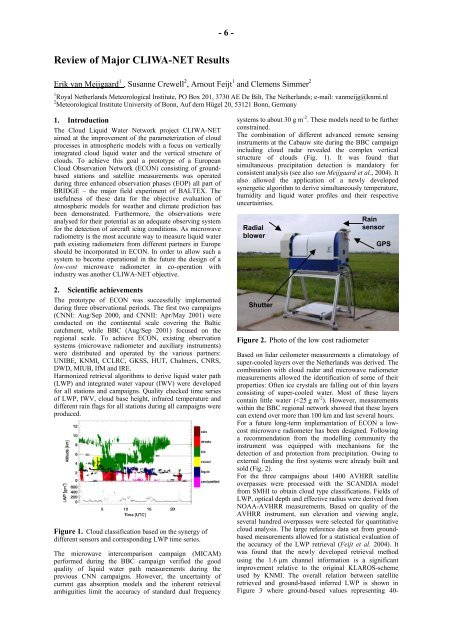Fourth Study Conference on BALTEX Scala Cinema Gudhjem
Fourth Study Conference on BALTEX Scala Cinema Gudhjem
Fourth Study Conference on BALTEX Scala Cinema Gudhjem
Create successful ePaper yourself
Turn your PDF publications into a flip-book with our unique Google optimized e-Paper software.
-6-<br />
Review of Major CLIWA-NET Results<br />
Erik van Meijgaard 1 , Susanne Crewell 2 , Arnout Feijt 1 and Clemens Simmer 2<br />
1 Royal Netherlands Meteorological Institute, PO Box 201, 3730 AE De Bilt, The Netherlands; e-mail: vanmeijg@knmi.nl<br />
2 Meteorological Institute University of B<strong>on</strong>n, Auf dem Hügel 20, 53121 B<strong>on</strong>n, Germany<br />
1. Introducti<strong>on</strong><br />
The Cloud Liquid Water Network project CLIWA-NET<br />
aimed at the improvement of the parameterizati<strong>on</strong> of cloud<br />
processes in atmospheric models with a focus <strong>on</strong> vertically<br />
integrated cloud liquid water and the vertical structure of<br />
clouds. To achieve this goal a prototype of a European<br />
Cloud Observati<strong>on</strong> Network (ECON) c<strong>on</strong>sisting of groundbased<br />
stati<strong>on</strong>s and satellite measurements was operated<br />
during three enhanced observati<strong>on</strong> phases (EOP) all part of<br />
BRIDGE – the major field experiment of <strong>BALTEX</strong>. The<br />
usefulness of these data for the objective evaluati<strong>on</strong> of<br />
atmospheric models for weather and climate predicti<strong>on</strong> has<br />
been dem<strong>on</strong>strated. Furthermore, the observati<strong>on</strong>s were<br />
analysed for their potential as an adequate observing system<br />
for the detecti<strong>on</strong> of aircraft icing c<strong>on</strong>diti<strong>on</strong>s. As microwave<br />
radiometry is the most accurate way to measure liquid water<br />
path existing radiometers from different partners in Europe<br />
should be incorporated in ECON. In order to allow such a<br />
system to become operati<strong>on</strong>al in the future the design of a<br />
low-cost microwave radiometer in co-operati<strong>on</strong> with<br />
industry was another CLIWA-NET objective.<br />
2. Scientific achievements<br />
The prototype of ECON was successfully implemented<br />
during three observati<strong>on</strong>al periods. The first two campaigns<br />
(CNNI: Aug/Sep 2000, and CNNII: Apr/May 2001) were<br />
c<strong>on</strong>ducted <strong>on</strong> the c<strong>on</strong>tinental scale covering the Baltic<br />
catchment, while BBC (Aug/Sep 2001) focused <strong>on</strong> the<br />
regi<strong>on</strong>al scale. To achieve ECON, existing observati<strong>on</strong><br />
systems (microwave radiometer and auxiliary instruments)<br />
were distributed and operated by the various partners:<br />
UNIBE, KNMI, CCLRC, GKSS, HUT, Chalmers, CNRS,<br />
DWD, MIUB, IfM and IRE.<br />
Harm<strong>on</strong>ized retrieval algorithms to derive liquid water path<br />
(LWP) and integrated water vapour (IWV) were developed<br />
for all stati<strong>on</strong>s and campaigns. Quality checked time series<br />
of LWP, IWV, cloud base height, infrared temperature and<br />
different rain flags for all stati<strong>on</strong>s during all campaigns were<br />
produced.<br />
Figure 1. Cloud classificati<strong>on</strong> based <strong>on</strong> the synergy of<br />
different sensors and corresp<strong>on</strong>ding LWP time series.<br />
The microwave intercomparis<strong>on</strong> campaign (MICAM)<br />
performed during the BBC campaign verified the good<br />
quality of liquid water path measurements during the<br />
previous CNN campaigns. However, the uncertainty of<br />
current gas absorpti<strong>on</strong> models and the inherent retrieval<br />
ambiguities limit the accuracy of standard dual frequency<br />
systems to about 30 g m -2 . These models need to be further<br />
c<strong>on</strong>strained.<br />
The combinati<strong>on</strong> of different advanced remote sensing<br />
instruments at the Cabauw site during the BBC campaign<br />
including cloud radar revealed the complex vertical<br />
structure of clouds (Fig. 1). It was found that<br />
simultaneous precipitati<strong>on</strong> detecti<strong>on</strong> is mandatory for<br />
c<strong>on</strong>sistent analysis (see also van Meijgaard et al., 2004). It<br />
also allowed the applicati<strong>on</strong> of a newly developed<br />
synergetic algorithm to derive simultaneously temperature,<br />
humidity and liquid water profiles and their respective<br />
uncertainties.<br />
Radial<br />
blower<br />
Shutter<br />
Figure 2. Photo of the low cost radiometer<br />
Rain<br />
sensor<br />
GPS<br />
Based <strong>on</strong> lidar ceilometer measurements a climatology of<br />
super-cooled layers over the Netherlands was derived. The<br />
combinati<strong>on</strong> with cloud radar and microwave radiometer<br />
measurements allowed the identificati<strong>on</strong> of some of their<br />
properties: Often ice crystals are falling out of thin layers<br />
c<strong>on</strong>sisting of super-cooled water. Most of these layers<br />
c<strong>on</strong>tain little water (













